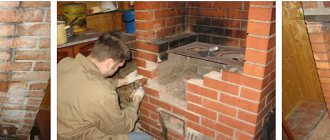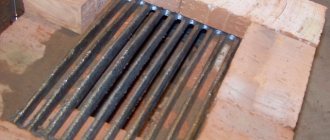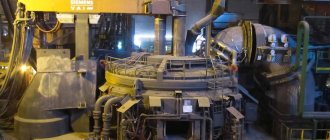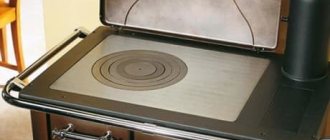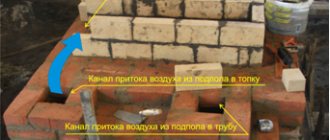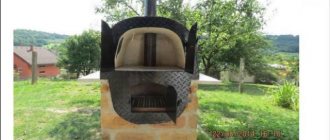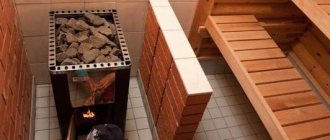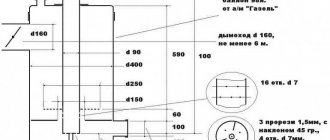Item for arranging the furnace
Choose the optimal location for the heating stove. As an example, a stove installed in the center of the room will give off heat as efficiently and evenly as possible. However, such placement of the stove is not always convenient.
Stove in the middle of the room
If the stove structure is placed against the wall (this option is the most popular and often used), cold will flow across the floor of the house.
Select in advance the location of the combustion chamber door. Design the stove so that in the future you will not have to carry fuel throughout the room, spreading dirt around the room.
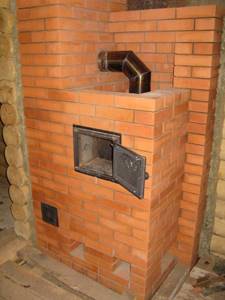
The heating stove is located against the wall
The best option is to install a firebox in a room that is rarely visited.
Recommendations regarding the foundation are standard - an individual concrete foundation is installed. It cannot be connected to the main foundation.
Calculate the design of the foundation in such a way that it is able to withstand the load not only of the furnace itself, but also of the smoke exhaust structure, which is also strongly recommended to be built of brick.
Wood-burning heaters also differ in the type of firebox, which can be remote or built-in

Remote. They are located separately from the stove in a room next to the steam room. Such placement makes it possible to reduce losses of thermal energy, simplify the process of supplying fuel and heat not only the steam room, but also other rooms in the bathhouse. Installation of a stove with a remote-type firebox in a wooden bathhouse must comply with all fire safety standards; therefore, a partition connecting to it is necessary Be sure to make it out of brick.
Built-in. An ideal option for a small bathhouse. This design ensures the concentration of the released thermal energy within the steam room, but you will also have to add firewood as you take bath procedures without leaving the room.
There are models of wood stoves equipped with a tank for preparing hot water. This is convenient when the steam room does not have hot water supply. The water tank also requires a choice, and this choice affects which stove is right for you. In addition to different volumes, the tanks differ in the method of connection to the furnace.
Why is it needed?
As has already become clear, the grate is a grate that allows the air flow to penetrate directly to the combustion center below, and the ash to be removed through the holes to a specially designated place for it. So why do we need grates in a furnace? Installing a grate in a furnace allows you to solve a number of problems:
- Divides the combustion chamber into two zones - the combustion chamber itself and a niche for ash.
- Used for placing and drying fuel.
- Distributes the air flow from the ash pan.
- Promotes good traction.
- Together with the door it makes it possible to control and regulate the flame.
The grate, which is intended for installation in the stove, cannot be made from any metal. Since it is constantly exposed to high temperatures and oxygen, it can begin to oxidize very quickly. Only cast iron can survive in this environment for a long time
Wood stoves can be closed or open
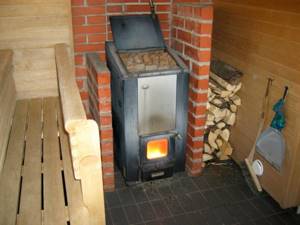
According to the location of the stones on the stove, they can be: with a closed heater (not ventilated) and with an open one (ventilated). In the first version, the stones are not visible; they are located in a niche, inside the stove itself. Such units are a very recent development of Finnish manufacturers. It makes it possible to maintain the temperature in the steam room for a longer period of time. In addition, such wood-burning stoves produce so-called “light”, that is, moist and soft steam at comfortably low air temperatures. In the second option, an open heater heats up the steam room faster and provides high temperatures in it, as well as low humidity parameters. The stones lie on top and water must be poured directly on them. It is not recommended to pour a lot of water onto hot stones, as the steam becomes very damp and worsens the microclimate in the steam room. With a closed heater, the steam is softer and more humid at a relatively low temperature in the steam room. Exposed stones create a higher temperature in the steam room with less humidity.
Self-installation of the grate
When heated, any metal will expand, therefore, the grate must be installed with a gap of at least 0.5 centimeters on each side. The ledge in the combustion chamber should be cut off (we are talking about the one on which the edges of the grate are laid). If the heating stove is made of brick, then the place for installing the grate should be located below the door at a distance corresponding to the height of one brick. This can be explained very simply: such a rise will prevent burning coals from falling onto the floor.
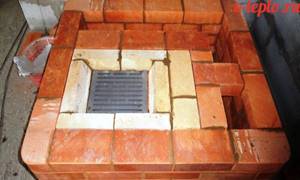
Also, during installation, you do not need to embed the grille too tightly. The degree of expansion for different materials is also different, therefore, too strong fixation of a cast iron product can cause cracks in the brickwork or deformation of the metal. Upon completion of the installation of the grate, the grooves must be tightly filled with sand (but without using cement!).
On a note! In the case of a triangular cross-section of the grate rods, the product must be laid exclusively with triangles downwards!
Operating principle
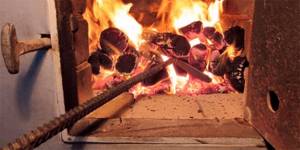
The operation of a deck oven differs from a classic one. The main property of such products is high efficiency with minimal fuel consumption. Burnout is distributed evenly. Thanks to the air entering through the firebox door, sufficient oxidation of the firewood occurs, increasing the quality of its combustion and the level of heat release.
The loading of firewood is carried out at the lower level in the loading chamber. Then the combustion process occurs in the working area. Gases are removed from the upper level and heat exchange occurs.
To maintain high temperatures (about 400°C), the furnace body is made of polished stainless steel. The lining is made of fireclay bricks or other fire-resistant material.
Specifications
There are many types of stoves, varying in size, type of fuel used, and other characteristics. Therefore, the grate for them will also be different. As for the material of the stove itself, it does not directly affect the choice. Grates are installed in brick, steel, and cast iron devices.
Type of design
There are gratings:
- monolithic;
- typesetting;
- refrigerated.
Monolithic are solid structures. Dimensions are selected depending on the depth and width of the combustion chamber.
Available to fit all standard firebox sizes. This option is the easiest to install.
The typesetting version is made up of individual rod elements. It is used if a standard one cannot be selected, for example, in non-factory-made ovens.
Important! Often the rods are wedge-shaped. When installing, they are positioned with the narrower part down
This increases service life.
Cooled ones are used in systems with heat exchangers. They are made of tubes through which coolant passes. Thus, the grate itself is cooled, and the overall efficiency increases. This option is more often used in solid fuel boilers. The temperature inside the chamber reaches 1000°C. Thanks to cooling, the material can withstand a similar thermal load.
Form
The grate bars differ in the shape of the canvas. Different types are used in different designs. The following types of gratings are available:
- flat;
- basket;
- movable;
- beam
Photo 1. Basket grate made of cast iron. This type of device is usually installed in fireplaces.
Flat (or tiled) - the most common type. They are installed not only in stoves, but also in boilers that burn solid fuel, as well as in fireplaces. They have a rectangular shape. The dimensions are standard, selected depending on the dimensions of the fuel chamber.
Baskets have curved edges, which is why the whole structure resembles a basket. Such structures are placed in open-type ovens intended for cooking. Since such stoves are rare nowadays, and the parts for them are also not very common.
Movable grates are installed in long-burning furnaces, where it is necessary to regulate the air flow. The design allows for the possibility of changing the width of the gaps. They have several sections and a shaft, thanks to which movement occurs. Rotation axes can be horizontal or vertical. An additional advantage is greater ease of cleaning.
Beams consist of individual crossbars (beams), which can be single or double. They are typically used in non-standard sized ovens.
Size
The dimensions of the product depend on two parameters:
- dimensions of the furnace combustion chamber;
- type of fuel used.
In equipment operating on wood, peat and fuel briquettes, a width of 150-350 mm (in increments of 50 mm) is most often used.
The depth is usually 180 or 250 mm. The largest possible dimensions of standard models are 900x800 mm.
When coal burns, more harmful substances are formed. Therefore, the dimensions of the grille should be larger, from 300-350 mm on both sides.
In any case, gaps of at least 5 mm are left at the edges. They serve to compensate for expansion when heated.
Attention! When choosing a size, the weight of one load of fuel is also taken into account. Dimensions, especially thickness, are selected in such a way as to withstand this load
Wood-burning sauna stove: how to choose
A person who decides to build a bathhouse will definitely be faced with the question of how to choose a stove and which model to prefer. There are enough characteristics to get confused. Therefore, we will try to systematize the main types and characteristics.

In order for a wood-burning heater to warm up a steam room well, retain heat for a long time and meet your requirements, it is important to know when purchasing it that the heat output of the stove must fully correspond to the volume of the steam room. Installing a wood-burning stove in a bathhouse that has low power and a large room volume will lead to the stove starting to overheat and function at the limit of its capabilities. Consequently, its service life will be significantly reduced, and bath procedures will take place at too low temperatures. If you take a stove that is too powerful than necessary, the room will overheat, which will lead to a reduction in the service life of the device. The finish will begin to crack, building and other materials will deteriorate. The oven will quickly break down when operating in such a confined space.
To calculate the required furnace power, first find out the volume of the steam room. To do this, you need to multiply its length, width and height. Without all the side factors, 1 kW of furnace power warms up a room volume of 1 m³. Further, if the room has non-insulated surfaces: windows, glass doors, ceramic tiles, or a brick wall, this must be taken into account when calculating. It is recommended to add each uninsulated square meter of the steam room to its total volume. Manufacturers usually indicate this in the furnace data sheet on how to make the calculation correctly. It is worth noting separately that when choosing wood-burning stoves, it is extremely important to purchase a unit that has a 20-30% power reserve.
Main functions of grate bars
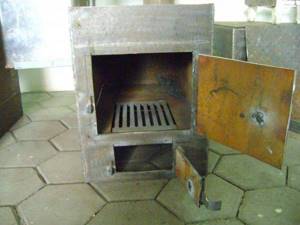
Any boiler is a structure where each part performs a specific task, ensuring the uninterrupted operation of the entire device.
The grate bars in the furnace perform the following functions:
- Placement of fuel - coal, firewood, briquettes, and other flammable items. Air enters through the blower, ensuring the presence of oxygen necessary for the thermal reaction.
- Removing ash and ash. As the loaded material burns out, it turns into a powder and spills down through the grates. The fuel settles on the surface of the metal, and the flow of oxygen to it improves. This frees up space for loading the next portion of fuel.
The efficiency of the boiler depends on the design of the grates; the correct choice of metal for its manufacture ensures the longevity of the device.
What is better: a hearth stove or a grate stove?
When purchasing a heating device, the question arises: a hearth stove or a grate stove, which is better to buy?
Expert opinion
Nikolay Davydov
Stove maker with 15 years of experience
It all depends on the basic requirements for the device. The hearth product is more airtight and safer, retains heat longer. In such a furnace, carbon dioxide emissions are minimal (4-5 times less than that of a “competitor”). But the device with a grate heats up faster and has an efficiency of 3-5% higher.
Types of grates for a fireplace or stove
For the manufacture of grate bars, various materials and various designs can be used. In most cases, heat-resistant steel or cast iron is used.
The fact is that the grates are constantly exposed to fire and therefore it is better to choose cast iron. since it has a high strength index. There are two types of grate:
The furnace firebox can have different sizes and shapes, so furnace casting manufacturers make all sorts of configurations. For a firebox with non-standard dimensions, you can also easily select a suitable model. Solid types include monolithic types without the possibility of disassembly. The choice of sizes is quite wide, so the main reference point is the firebox area. The basis of typesetting models is made up of several individual elements. This is something like a constructor. which you can assemble with your own hands and get the desired grille size.
Steel grates for a type-setting stove have the form of a conveyor belt and are called chain grates, and models with the possibility of cooling and made from pipes with your own hands are called pipe grates.
Cast iron grates can be of several types:
- tiled. Rectangular models used for solid fuel boilers, fireplaces and heating stoves. They are universal, the main thing is to determine the standard size;
- basket Ideal for an open hearth. The main purpose is cooking, but today they are used extremely rarely, since the design is morally outdated;
- beam These models owe their name to their resemblance to construction beams. They have the appearance of a stacked structure and consist of double or single elements. The optimal solution if you need to assemble a grate of non-standard size;
- movable. Such gratings have a design feature. allowing you to change the width of the gaps, which is often not enough during installation. In most cases, they are used in long-burning furnaces.
There are three types of water tanks

“Samovar” type tank. This is a tank on the chimney pipe. The chimney from the sauna stove passes through the water tank and the hot exhaust gases heat the water. This tank has a filler and drain hole. Typically, it is made of stainless steel.
Mounted tank. Such a tank is located close to or hangs on the furnace body. The water in it is heated by heat from the walls of the furnace body itself.
Remote tank. This is a separately hanging tank, which can even be in another room. It connects to the heat exchanger in the furnace and due to this, the water is heated. But for such a tank, to heat the water you need a special stove with a built-in heat exchanger. If you decide to choose a stove with a heat exchanger, it becomes possible to heat the steam room itself and adjacent rooms: dressing room, locker room, and other rooms
Grate design
The size of the grate depends on the fuel that will be used in the future. For everyday use, two designs are recommended - solid and composite.
The first option consists of a cast iron grate, which is selected according to the size of the combustion chamber. The second type is assembled from individual elements.
The size of a composite grate is determined in the same way as a solid one, based on the size of the firebox. In addition to differences in type, devices are also divided by functionality.
The design of the cast iron grate comes in two types: full-rotating and swinging. In the first case, the elements have the ability to rotate horizontally by 180 degrees, which allows you to dump ash and slag.
This design involves grooves in the combustion chamber for additional holes. It is extremely difficult to make a full-circle system at home.
In the second design, the elements have cradle-like movement elements, rotating around at an angle of 30 degrees. This system has the ability to loosen accumulated slag.
By design, the grate can be chain or pipe. In the first case, the model resembles a conveyor belt. In the second, it is made of pipes and has a cooling function.
The cooled grate consists of a cast coil, which is made of cast iron. This type is used in water heating and pipe water supply systems. Coolant circulates inside the cooled grate device. Cooling is used when burning coal, since its temperature is a thousand degrees.
Materials and blanks
Cast iron elements

The range of components and volumes of required building materials depend on the type of stove design chosen, within which they differ little. For purely heating samples, it is not necessary to include a hob, oven, or water tank in the project. A typical set of elements made of cast iron and steel includes the following items:
- door for the ash pan and its combustion equivalent;
- cleaning channel doors;
- street chimney valve;
- burners;
- the hob itself.
This list is completed by the grate, traditionally made of cast iron.
In addition to all of the above, steel parts will be required to construct the structure. Their list includes the following items:
- built-in oven;
- container for water;
- stripes of arbitrary length and width;
- corner size 50x50 mm;
- well-annealed wire 2-3 mm;
- steel sheet laid near the firebox.
Red and fireclay fire bricks
To make the base (foundation) and the furnace body, you will need to prepare consumables. They are selected based on the selected masonry scheme and taking into account a special table, usually attached to it.
This list includes:
- crushed stone, rubble stone, as well as broken brick, simple sand and cement;
- boards for arranging formwork for the foundation and a piece of roofing felt for waterproofing;
- two types of bricks;
- asbestos sheet and marking cord;
- initial components for preparing clay mortar.
Cast iron grate for furnace
Over the centuries, the external and internal design of the stove has been changed and improved in order to increase heat output. Structurally, elements such as the valve, stove, oven could change over time, but an important element of the hearth remains unchanged - the cast-iron grate for the stove.
The configuration, dimensions, and cost of the grate depend on the design features of the furnace, as well as the type of solid fuel. The grate is a grate installed in the firebox, dividing it into two parts: the ash pan and the combustion chamber. It provides the formation of an air flow that supports the combustion process of solid fuel due to natural convection.
Tasks and types
Solid fuel is placed on the stove grate, and the ash formed during its combustion is poured through the grate holes into the ash pan. The resulting slag prevents the grate from overheating. The grate provides high-quality draft from bottom to top, and together with the oven door allows you to regulate the strength and duration of the flame.
Cast iron and steel are used to produce gratings. Cast iron grates are installed in stoves and fireplaces because they do not require special operating conditions and can withstand high temperatures well. Steel grate bars are used primarily in industrial workshops. The dimensions of cast iron grates for a stove, as well as their weight, depend on the type of fuel used.
Depending on the type of construction, there are two types of cast iron grates:
The one-piece type of grates cannot be disassembled; it is selected individually for the stove depending on the size of its firebox.
Prefabricated grate bars consist of a certain number of elements from which a grate of the required dimensions can be assembled.
There are four types of grate shapes:
- Tiled flat model
A universal flat rectangular grille, suitable for most solid fuel fireplaces, boilers, and stoves. To buy one, you need to know exactly the size of the firebox.
Basket
A design of this type was used on open fireplaces; today it is obsolete.
Beam
The design of this type is a kit model consisting of single or double cast iron slats, from which you can assemble a grill of non-standard dimensions. When using a beam grate, the slats must be freely placed in and out of the firebox, while there must be a gap for expansion of at least 5 mm to avoid deformation of the metal and masonry.
Movable
A long-burning stove is usually equipped with a movable grate. This is a structure consisting of a shaft and several moving sections. The vertical and horizontal axis of rotation of the shaft improves the process of fuel combustion and cleaning the grate from ash, while the width of the gaps in it is adjustable. A rotation angle of 30 degrees leads to loosening of the slag and shedding of ash into the ash pan. The angle can also be 180 degrees, but the installation of such a movable grate requires the presence of special recesses in the brick, so it has a high cost and limited use.
A separate type are cooled grates, or KROK, installed in hot water furnaces and water heating boilers. They are made from solid cast iron pipes. Air is supplied through special holes, showering the ash, while maintaining a temperature of up to 1000 degrees of hot solid fuel. Coolant circulates inside the tubes, cooling them.
Selection rules
The selection of the appropriate grate model should be based on the type of fuel used. The size of the grate and the weight it must withstand when loading firewood into the firebox depend on this. Small grates are used for wood stoves and fireplaces, and large grates are used for coal stoves. The minimum grate size is 140x120 mm, the maximum is 800/900x200 mm. The optimal size for burning wood is 140/330x120/252 mm, for coal - 350/300x205 mm.
When installing a grate in the firebox of a fireplace or other stove, it is necessary to make recesses around its perimeter of at least 5 mm, since the metal will expand when heated. The ledge on which it will be installed must be hewn. If the installation is in a brick fireplace, the grate should be placed one brick below the door so that the coals do not fall out of the firebox. After laying, the grooves are filled with sand (without adding cement). Correct installation of the grate is carried out when the grate is placed with expanding gaps between the rods downwards, and not upwards.
It doesn’t matter what shape or cost the grate has. Its quality can only be judged by the material from which it is made, the thickness of the grille bars and the size of the gaps between them.
Grateless sauna stoves
A bathhouse is an area where people and buildings are exposed to high temperatures.
In order to correctly develop the design of a sauna stove that meets all standards, as well as the functional and aesthetic needs of consumers, you need a deep understanding of the processes occurring in the sauna stove and steam room, knowledge of the features of the stoves and their installation. Wood-burning sauna stoves from the Sukhovey plant of Feringer are developed on the basis of original design solutions aimed at improving the operational and consumer properties of the products: increasing service life, ease of installation and placement in the steam room, fuel efficiency, versatility and others. When developing stove designs, we take into account the volume of the steam room and adjacent rooms that require heating, the number of people simultaneously taking bath procedures, as well as the presence of a container for heating water or steaming a broom. Many years of experience of the best specialists of our company and an attentive approach to the wishes of customers help improve the designs of sauna stoves and expand their range. Our stoves for the Sukhovey bathhouse are environmentally friendly, hygienic, safe and have certificates of compliance with the requirements of the State Standard of Russia and fire safety. All this makes wood-burning stoves for the Sukhovey bathhouse ideal for connoisseurs and lovers of Russian bathhouses.
It is known that in wood-burning sauna stoves with a grate, air is supplied 10–15 times more than is necessary for the combustion process. Together with excess air, up to a third of the heat leaves the oven. In addition, unburnt fuel (a tenth of the total volume of firewood) falls into the grate holes. And these coals make up 99% of what we call ash. Therefore, every time after using the stove, it must be cleaned to empty the ash pan.
The grateless stoves for the Sukhovey bathhouse do not have all these disadvantages, therefore their efficiency is much higher than in stoves with a grate. The fuel in these stoves burns completely, and so little ash remains that the sauna stove has to be cleaned once every 15–20 burns. For example, in the traditional Russian bell stove, in which cabbage soup was cooked, bread was baked, and steamed, there was never a grate. They appeared when coal began to be used. A wood-burning sauna stove does not need a grate at all. In my own bathhouse I have been using a grateless stove for 3 years. Ash has to be removed only once every six months.
OPERATING DIAGRAM OF A GRITT OVEN
The air supply occurs through the ash pan and cannot ensure smooth adjustment of the combustion mode. The highest temperature is created in the grate zone, which leads to deformation and intense scaling of the grate, bottom and ash pan. The fuel lying on top creates a screen and prevents heat from spreading smoothly throughout the entire volume of the furnace. And excess air flow carries heat into the atmosphere. The tunnel area does not participate in the general air flow, so intense soot deposits on the door glass. After the first fire, the glass becomes opaque. Fuel loss ranges from 5% to 15%. All unburned fuel falls into the grate holes.
After each fire, the ash pan must be emptied
from the ash. However, not all the ash ends up in the ash pan—some of it remains in the firebox—so there is a need to clean the firebox itself.
OPERATING DIAGRAM OF A GATELESS OVEN
The air supply is smoothly regulated by a damper
and allows you to regulate the fuel combustion activity. the fuel burns completely, leaving only the salts contained in the wood, which make up 0.2% -0.3% of the mass of the firewood. ash plays the role of additional protection for the bottom of the sauna stove. Ash removal is carried out only once after 15–20 firings of the furnace.
The air supply through the damper at the top of the door protects the door and glass from overheating and prevents soot from settling on the glass.
The absence of a grate and ash pan allows you to change the shape and size of the firebox, thereby achieving the greatest efficiency of heat extraction.
Advantages of a grateless oven:
— fuel burns completely and evenly; — burnt fuel serves as additional protection for the bottom of the firebox; — using a damper you can smoothly regulate fuel combustion; — the air flow blows across the glass and prevents soot from settling on it; — cleaning the firebox from ash is done once after 15–20 firings of the furnace.
What functions do grates for furnaces perform?
This element of stove fittings allows you to achieve high-quality combustion of fuel and maintain it while the stove is burning.
When one portion of firewood or coal burns out, the ash is poured out, and the top layer of fuel is shifted to the grate, where it is better blown by the air coming from the ash pit and burns more intensely. Thanks to the presence of grates, the task of drying wet fuel is simplified.
The efficiency of the furnace depends on the design of the elements, and the durability depends on the material from which they are made.
It is also important to install the grille correctly so that it fully performs its functions.
For the manufacture of stove fittings, cast iron and heat-resistant steel are most often used. The grate bars are constantly exposed to flame, so it is better to give preference to cast iron, because it is more durable.
Furnace fireboxes vary in size and come in different shapes, so manufacturers produce furnace castings of all possible configurations. For non-standard fireboxes, you can also find a suitable model. Grate bars can be:
- Solid. Monolithic models that cannot be disassembled. There are different standard sizes; when choosing, you should focus on the area of the firebox.
- Typesetting. Consist of separate elements. This is a kind of “constructor” that you can assemble yourself and get a grill of the desired size.
Steel grates are made of chain type (reminiscent of conveyor belts) or pipe type (cooled models made of pipes).
There are several types of cast iron:
- Tiled. These are rectangular models that are installed in solid fuel boilers, heating stoves, and fireplaces. They are universal, the main thing is to choose the right size.
- Baskets. A good option for open hearths intended for cooking, but since they are practically not used, the design is obsolete.
- Beam. They got their name because of their external resemblance to construction beams. These are stacked structures consisting of single or double elements. Well suited for assembling grates of non-standard sizes.
- Movable gratings. They are called movable because of the design features that allow you to change the size of the gaps. Grates of this type are most often chosen for long-burning stoves.
Movable grid design. Element numbered 1 is the thrust, 2 is the horizontal axis of rotation, 3 is the grid itself.
The grate must be taken in such a way that the rods can withstand the maximum possible weight of one portion of fuel. You can check with the seller how much a particular model can withstand.
If in doubt, consult a specialist.
In order for the grate to be well cleaned of ash, the gaps must occupy at least 40% of the area of the entire structure. If there are fewer of them, the firebox will work less efficiently, because the amount of incoming air is not enough for intense combustion. If there is insufficient ventilation, gases may accumulate. If the area of the gaps is larger, then unburnt fuel will be poured into the gaps along with the ash.
Metals expand when heated, so grates must be installed with a minimum gap of 5 mm on all sides. In the firebox you need to cut off a ledge on which the grate is laid with its edges. In a brick oven, the location is usually chosen one brick below the firebox door. This is necessary to prevent burning coals from falling onto the floor.
During installation, it is not advisable to tightly bury the grates. Different materials expand to different degrees when heated, so too strong a fixed fixation of a metal element can result in deformation of the metal or cracks in the masonry. Having laid the grate, the grooves are tightly filled with sand without cement.
Let's sum it up
- The best material for grates is cast iron. It is reliable and durable, it can be installed in brick and even steel ovens.
- When choosing a grate, you need to take into account the weight of the fuel and the area of the gaps. Monolithic models are easier to install, while modular models are well suited for assembling gratings of non-standard sizes.
- When installing, be sure to leave gaps for metal expansion and do not fill the grooves with cement.
If you take into account all these nuances, the new grate will last for decades, and you will not need to think about replacing it.
Advantages and disadvantages of wood stoves
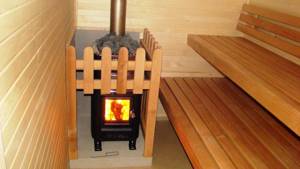
Wood-burning heaters have many fans. The first point is that nothing can compare with the peaceful and cozy crackling of wood in the stove, its unique smell and the magic of an open, living fire. A wood-burning sauna stove is preferred by those of us who value traditions and special kindling rituals.
As for the practical considerations that force you to choose such heaters, they are also present. When a steam room is built on an area where gas is not supplied, you have to choose between electricity and firewood. Electricity is much more expensive, firewood is quite affordable and can be prepared in reserve. Another important advantage is that a wood-burning heater makes it possible to quickly achieve the desired temperature in the room and maintain it for a long time. The disadvantages of such stoves include the fact that during bathing procedures it is necessary to regularly throw logs into the firebox so that the flame does not go out. In addition, in the process of burning wood, carbon monoxide and smoke are formed, and it becomes necessary to install a reliable exhaust chimney.
A little history
Previously, firewood was burned on a blind hearth - combustion air was supplied through a slightly open fire door. This method has a fire hazard - coals may fall out of the firebox. It is also difficult to accurately select the optimal combustion mode - the regulator is very rough. The ash that covered the coals over time also did not contribute to the normal combustion of fuel - it is an excellent heat insulator (in the combustion chamber of a Russian stove, this is exactly how coals were stored in the ash for the next kindling). Therefore, they began to install a grate - a grate on the hearth through which oxygen enters the combustion zone. The ash is also removed through the grate - nothing interferes with the combustion processes.
The absence of a grate or its damage is not critical - the stove operates without it. True, the efficiency is somewhat lower. And the zone of intense heating of the masonry moves below the hearth - now the base of the ash chamber is also heated. And here you need to be careful if the stove is installed on a wooden base.
The material from which the heater is made is of great importance.
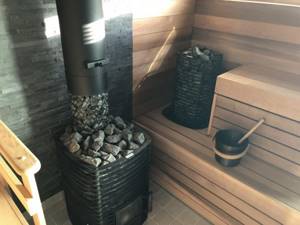
Most heaters today have a steel or cast iron body. Wood-burning heater stoves made of heat-resistant chromium steel have proven themselves well. The chromium content in it is at least 15%. This stove is good because it does not burn oxygen in the room, thereby creating more comfortable conditions for steam procedures. Almost all industrial wood stoves have a multi-layer metal body. This prevents burns from accidental contact with the heater. This circumstance is especially important for small steam rooms, in which every free centimeter is worth its weight in gold. Models are also produced that are lined with natural stone or ceramic tiles. In this case, the stoves heat the rooms more evenly and remain comfortably warm. However, the cost of such cladding is quite high.
Pay attention to the volume of stones that the stove can accommodate. The more there are, the longer the heat in the steam room will last, which means the fuel consumption will be less. How to place stones in the oven and how many stones are needed is a purely individual matter. On average, you can calculate the number of stones based on the volume of the steam room - for each meter of volume you need approximately 20-30 kg of stones.
Types of grates
Grate grates are divided into several varieties according to different criteria.
So, they can be divided into monolithic and typesetting.
— Monolithic models of gratings are more common, they are much easier to install - they immediately fit into a nest prepared for them of the required dimensions. The wide range of shapes and sizes of gratings on sale most often allows you to get by with just this option.
Options for monolithic and prefabricated grate
— Prefabricated grate bars are assembled into a single structure directly at the seat. These can be modules with two or three jumpers.
A prefabricated grate is convenient in cases where the bottom of the combustion chamber has a complex geometric shape, that is, it should be narrower in one place and wider in another.
This also includes the so-called beam grate - this is also a stacked version, consisting of individual crossbeams. The elements of the beam grille must pass freely and be removed from the combustion chamber through the open door. Actually, if you look at it, it is precisely such a separate beam that is called a grate.
Features of use
The oven is easy to use. To warm up the product you need to do the following:
- Load pallets into wood stove. Gas and electric models are connected to the gas pipeline and the electrical network, respectively.
- Dry the heating element after idle time in an electric oven. Other types can be enabled immediately.
- Select the desired program mode.
- Preheat the chimney for 6-7 minutes.
- Check the thermostat indicators. The temperature is maintained automatically in most modern models.
If the oven is used for cooking, you need to open the lid and place sheets of kitchen utensils into the oven. After finishing, the device turns off. It should not be kept in working condition for more than an hour.
We begin to pour the foundation for a brick oven with our own hands
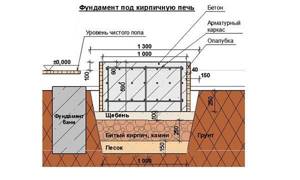
Foundation for a brick oven
Step 1. Marking for the foundation and pit
- Once you have decided on the location of the future furnace, you need to correctly calculate its dimensions based on power. It depends on the area of the room, the number of doors, windows, etc.
- We draw the required size of the oven on the ground. The foundation should be 15-20 cm larger than the heating structure. Make markings and install pegs that will mark the boundaries of the pit for the foundation pit.
- Using a bayonet shovel, dig a hole 70-100 cm deep, depending on the density of the soil and the climate zone (see above).
- We lay a sand cushion 10-15 cm thick at the bottom of the trench. We compact it tightly with a shovel and pour a layer of medium-fraction gravel to a height of 30 cm. Pour a bucket of water onto the surface of the sand-crushed stone cushion and compact it tightly.
Step 2. Installation of formwork and reinforcement
- Let's start building formwork from boards. In principle, any old boards or plywood that you have on the farm are suitable for formwork. This does not in any way affect the technical properties of the foundation.
- The formwork is a wooden box, which, for reliability, is fastened at the corners with metal corners. Connect the boards together using nails.
- We lower the finished formwork to the bottom of the pit.
- After the pillow is firmly compacted, it is necessary to waterproof the base. To do this, we measure the size of the pit onto the polyethylene, cut it out and attach the polyethylene to the walls along the perimeter of the formwork using a construction stapler.
- Reinforcement of the foundation is necessary in order to give rigidity to the entire structure. We will reinforce with steel rods with a cross-section of 12 mm, which must be connected to each other by welding in the form of a frame or metal wire with a cross-section of 0.8 mm.
- The final work on the construction of the foundation is joining the floor to the foundation. It is better to do this by laying an even row of bricks.
Marking and subsequent arrangement of the base
The foundation for the stove should not coincide with the foundation of the house
Before you build a brick oven with your own hands, you need to carry out a number of preparatory measures. Operations for laying a furnace structure are preceded by marking and pouring a foundation capable of supporting its weight. Before choosing a location, it is important to take into account that the chimney pipe, when passing through the ceiling, should be placed away from the wooden beams (at a distance of at least 120-150 mm).
According to the resulting markings, the boards are carefully cut out, after which access to the ground opens. In this place there will be a stove foundation that is not connected to the foundation of the entire house - the shrinkage of these two buildings is different. In the exposed soil, you will need to prepare a foundation pit 0.5 meters deep, and then begin arranging the foundation, constructed from rubble stone or broken bricks.
Preparation of solutions
The simplest solution is clay-sand. As you know, the fatter the prepared mixture, the more plastic it is, but when it dries it can crack greatly. A thin solution, on the contrary, is not very strong. A good mixture is a ratio of binders and filler that produces strength and no cracks when drying. To avoid mistakes when preparing the solution, take five identical portions of clay and pour into each the amount of water that turns this filler into a stiff dough. Do not add anything else to the first portion, and to the remaining portions, respectively, 10, 25, 75 and 100% sand (if the clay is oily - 50, 100, 150 and 200% each). The quality of the solution is checked this way. From each portion of the resulting dough, roll two or three balls with a diameter of 4–5 cm, and then make two or three cakes from these balls with a diameter of 2–3 cm. The best solution is the one from which the dried balls and cakes crack less (ideally not completely cracked). You can also throw the ball from a height of 1 m. A high-quality portion of the mixture will never crumble. The average consumption of mortar in the process of stove laying is usually one bucket per 15–25 bricks. However, it may vary depending on the thickness of the seam and what is being filled. If the masonry is jointed, then 1/10 of the cement will have to be added to the mortar to obtain the required joint thickness. Then the consumption of the mixture will, of course, increase. To prepare lime mortar
take slaked lime and sand in a ratio of 1:2 or 1:3. Add water to the lime and knead the dough, which is then strained through a sieve with cells of 0.3 x 0.3 cm. Following the dough, sift sand through the same sieve. Mix the lime dough with sand until you get a homogeneous mass. Add water if necessary. As a rule, two or three parts of sand are required for one volumetric part of lime paste. It is desirable that the solution be medium in fat content. The ingredients of cement mortar, in addition to the cement itself, are sand and water. This is the most durable of the mixtures. The ratio of sand and cement usually ranges from 1:3 to 1:9. The first stage of preparation is mixing cement with sand. The second is adding the required amount of water. Next, mix everything until a homogeneous mass is obtained. To make sure that the mortar is ready for use, you need to check whether it spreads over the trowel and is squeezed out of the seam when pressing on the brick.
